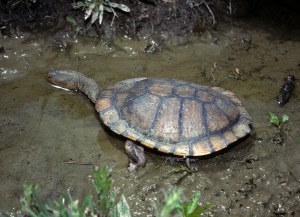 A number of small turtles have been released in western Sydney as part of a program seeking to make amends for a decline in native freshwater species.
A number of small turtles have been released in western Sydney as part of a program seeking to make amends for a decline in native freshwater species.
Around 20 juvenile eastern long-necked turtles with tiny trackers glued to their shells were released into lagoons at the Western Sydney University Hawkesbury campus, ABC News reports.
The campus is part of the wider Hawkesbury catchment, about 50 kilometres west of Sydney city.
The research was led by zoologist Ricky Spencer, who is worried about the decline in turtle numbers in the Hawkesbury and in other habitats such as the Murray River.
“There’s been a decline of freshwater turtles throughout south-eastern Australia largely because of introduced predators like the fox, which destroy 95 per cent of turtle nests each year,” he said.
“Eastern long-necked turtles are the most common turtle in the Sydney region and can live up to 100 years, but with a decline in the number of juveniles, the species effectively has an ageing population.”
The trackers on these turtles will be operational for about six months, and it is hoped they will reveal how many survive and where they will go.
Spencer said there was always a rate of nest predation, but he was concerned the rate of egg destruction by predators had increased. “By knowing many juveniles survive they can better calculate how many nests need protection,” he said.
“Turtles can handle high nest predation rates but the current levels, because of foxes, are far too high.
“We need to know what sort of levels do we need to get them down to, so that we can sustainably manage the populations.”
Last year Spencer and his team released about 2000 Murray short-necked turtles in South Australia, and will be following up shortly to see how many have survived.
Spencer added that the next step is understanding how to deal with the threat from foxes.
“We’ve been looking at the standard sort of fox-baiting, fox-shooting and a whole range of other techniques, but it’s been very difficult, we’ve go nothing concrete yet,” he said.
Funding for the research is being provided by the Australian Research Council.
SAM WORRAD

